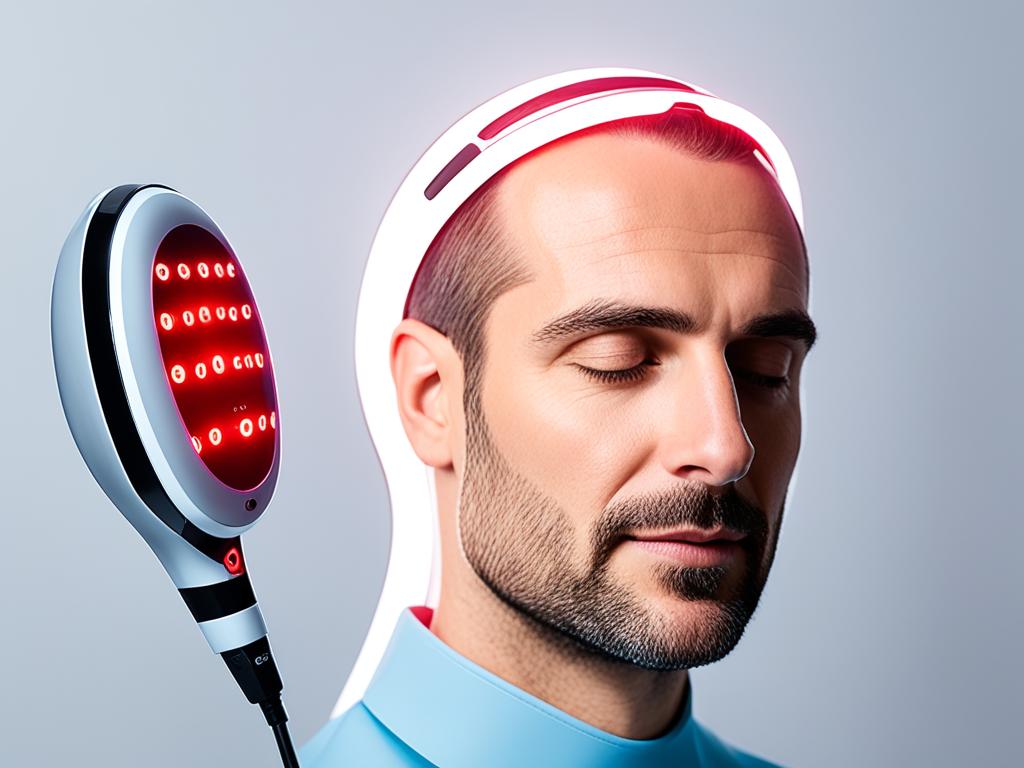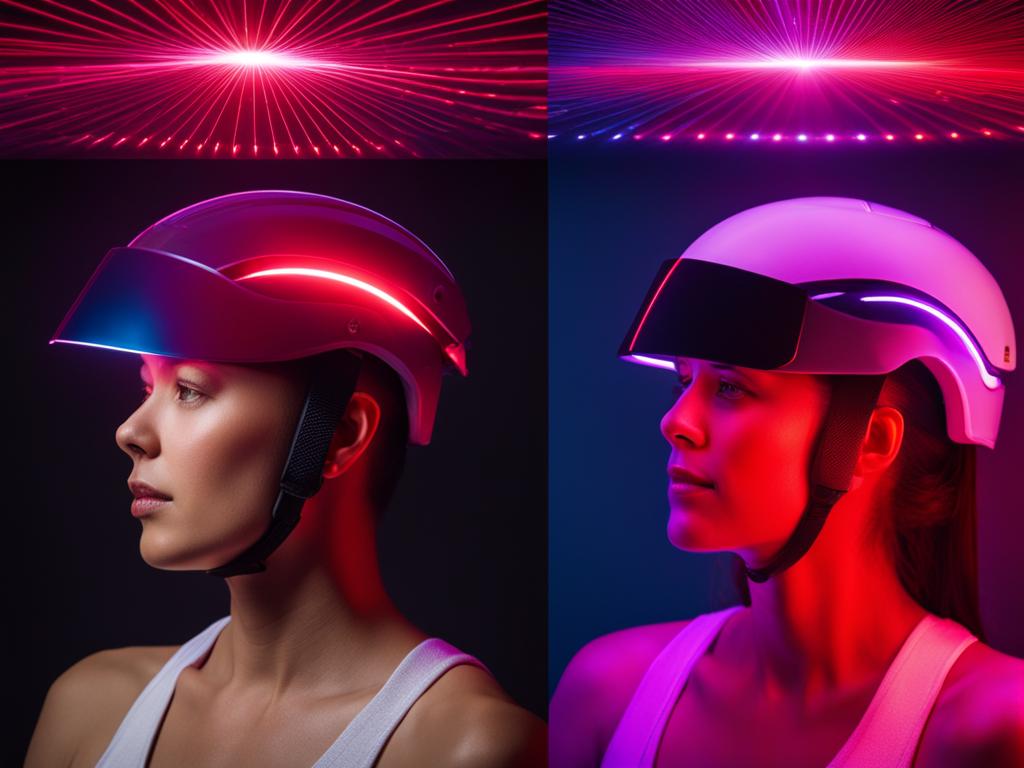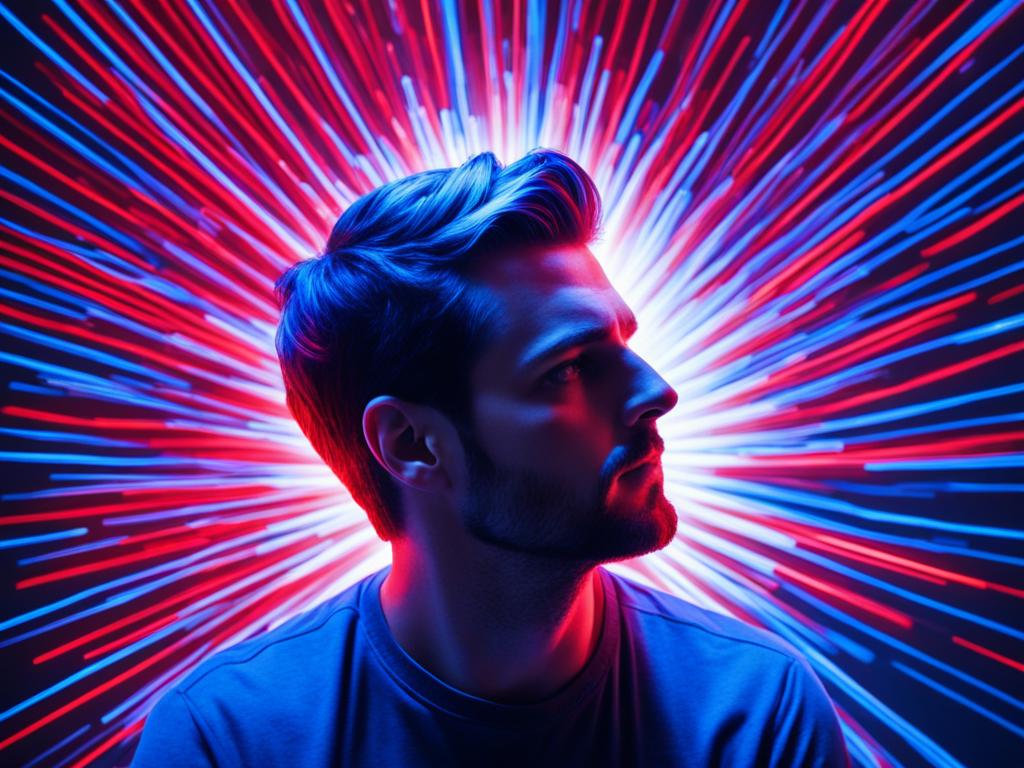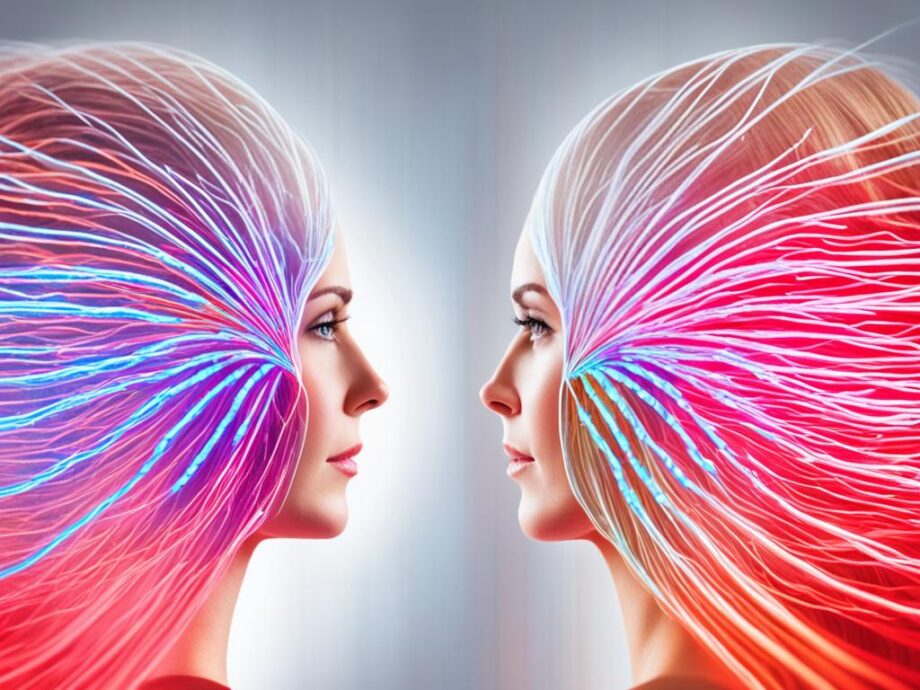Looking for a solution to hair loss or thinning hair can be a long and exhausting process. With countless products and treatments available in the market, it can be difficult to know which approach to take in your hair regrowth journey.
In recent years, LED and laser hair growth technologies have emerged as potential solutions. Both of these therapies use non-invasive and pain-free methods to stimulate hair follicles and promote healthy hair growth.
But which technology wins the battle of led vs laser hair growth? Let’s take a closer look.
Key Takeaways:
- LED and laser hair growth technologies are non-invasive and pain-free methods to stimulate hair follicles.
- Choosing between LED and laser hair growth ultimately depends on individual preferences, needs, and budget.
- Both methods have potential benefits for those seeking hair regrowth solutions.
- Exploring the scientific principles behind LED and laser hair growth treatments is essential in making an informed decision.
Understanding LED Hair Growth
LED hair growth technology has made considerable strides in recent years, providing a convenient and affordable way to promote hair regrowth from the comfort of your home. By using a specific wavelength of light, light-emitting diodes (LEDs) can potentially stimulate hair follicles and improve the overall health of your hair.
At-home LED hair growth devices are becoming increasingly popular, offering a viable solution for those seeking hair loss treatment without having to visit a clinic. The best hair growth devices are designed with ease of use in mind, ensuring they can be incorporated easily into your daily routine.
There are several different types of at-home LED hair growth devices available in the market, each with their unique features. Some of the best hair growth devices available today include:
| Device Name | Features |
|---|---|
| iRestore Laser Hair Growth System | Helmet design for full scalp coverage, clinical grade lasers for maximum efficacy |
| HairMax Laser Hair Growth Cap | Flexible cap design, FDA cleared to stimulate hair growth |
| illumiflow Laser Cap | Medical-grade lasers, wireless, portable, and hands-free design |
While at-home LED hair growth devices can potentially be effective, it’s important to note that results may vary, and they are not guaranteed for everyone. It’s essential to consult with a trusted medical professional before beginning any hair regrowth treatment.

Overall, LED hair growth technology offers a promising approach to addressing hair loss concerns, with at-home devices providing an affordable and convenient alternative to professional clinic treatments. For those seeking the best hair growth devices available in the market, a range of effective options can help stimulate hair regrowth and improve hair health.
The Power of Laser Hair Growth
Laser hair growth, also known as low-level laser therapy or LLLT, is a non-invasive hair regrowth treatment that uses red light wavelengths to stimulate the scalp’s cells and promote hair growth. This technology has been extensively researched and tested, with promising results for those experiencing hair loss or thinning.
During laser hair therapy, a device emitting red light is placed on the scalp, providing energy to the hair follicles. This energy triggers the follicles’ natural growth cycle, promoting the growth of thicker, healthier hair. Laser hair growth treatment may also improve blood flow to the scalp, providing the necessary nutrients for hair growth.
One of the key benefits of laser hair growth is its effectiveness in addressing various causes of hair loss. Whether hair loss is due to genetics, hormonal changes, or other factors, laser hair therapy has been shown to stimulate hair regrowth across the board.
Unlike LED hair growth devices, which can take longer to see results, laser hair growth tends to provide quick and noticeable improvements in hair density and thickness.
Laser Hair Therapy as a Hair Regrowth Treatment
Many hair growth experts believe that laser hair therapy holds promise as a safe and effective hair regrowth treatment. In one study, participants experienced a 39% increase in hair growth after completing laser hair therapy sessions over a 16-week period.
Additionally, laser hair growth treatment can be used in combination with other hair loss treatments, including medications and scalp massage. This “multi-therapy” approach can help address hair loss from multiple angles, potentially leading to even better results.
Is Laser Hair Therapy Right for You?
If you’re looking for a hair regrowth treatment that delivers quick and noticeable results, laser hair therapy may be the right choice for you. It’s non-invasive, safe, and has been shown to be effective across a variety of hair loss causes.
However, it’s important to note that laser hair growth may not work for everyone and may not be a permanent solution to hair loss. It’s best to consult with a hair loss specialist or dermatologist to determine if laser hair therapy is right for your unique needs and medical history.
Comparing LED and Laser Hair Growth Technologies
When it comes to hair growth technology, LED and laser devices are two popular options in the market. While both technologies aim to stimulate hair regrowth, there are some key differences to consider when deciding which method to choose. Let’s take a closer look at the similarities and differences between these two technologies.
| Technology | LED Hair Growth | Laser Hair Growth |
|---|---|---|
| Wavelengths Used | Uses a broader range of light wavelengths, typically from 630nm to 670nm, making it suitable for addressing a range of hair problems, from thinning to baldness. | Uses a narrow band of light wavelengths, typically from 650nm to 960nm, with varying benefits for specific issues concerning hair regrowth. |
| Frequency | Numerous devices are equipped to provide daily hair therapy sessions, making it easier to incorporate into daily routines. | Laser devices can be used two to three times a week, with sessions taking up to 20 minutes, requiring a larger time commitment than LED devices. |
| Cost | Many LED hair growth devices come at a lower price point than laser devices, making them a more affordable option for those just starting their hair regrowth journey. | The cost of laser hair treatments is often higher than LED devices, but provide a more intensive treatment solution suitable for severe hair loss problems. |
In general, LED therapy is more versatile and convenient for daily use, while laser treatments are often used as a more powerful solution for those seeking an intensive treatment. However, the effectiveness of each technology depends on the individual’s hair type, age, and pattern of hair loss. It’s important to consult with a dermatologist or a hair specialist to determine the most suitable option.

The Science Behind LED and Laser Hair Growth
LED light therapy and laser hair growth technologies have become increasingly popular in the treatment of hair loss. But, how do they work?
LED light therapy works by delivering specific wavelengths of light to the scalp – red and near-infrared light waves – to stimulate cellular function within the hair follicles. This process, known as photobiomodulation, promotes cell metabolism, increases blood circulation, and ultimately encourages healthier, stronger hair growth.
Laser hair growth technology, on the other hand, uses low-level lasers to stimulate hair growth at the root. The laser energy is absorbed by the cells within the hair follicles, ultimately leading to an increase in cell metabolism and blood flow for healthier, thicker hair.
Both technologies have been shown to be effective in stimulating hair growth and addressing hair loss. However, the scientific principles behind each are unique, and understanding these differences can help you decide which approach may be best suited to your needs.
How LED Light Therapy Works
The key to LED light therapy’s effectiveness is its ability to deliver the right wavelengths of light to the hair follicles. Red light waves, in particular, have been shown to promote collagen production and cell metabolism, which are essential for healthy hair growth.
Near-infrared light waves are also beneficial, as they penetrate deeper into the skin’s layers to increase blood circulation and oxygenation, providing crucial nutrients to the hair follicles.

How Laser Hair Growth Technology Works
Laser hair growth technology works by delivering low-level laser energy to the hair follicles. This laser energy stimulates the cell metabolism and increases blood flow to the area, which can promote new hair growth over time.
What’s unique about laser hair growth technology is that it is a non-invasive treatment – meaning that it does not require any surgical intervention. This makes it a much more appealing option for those who may not want to undergo more invasive hair loss treatments.
The Bottom Line
Both LED light therapy and laser hair growth technologies have scientific principles that support their effectiveness in promoting healthy hair growth. Understanding how these therapies work can help you make informed decisions about which approach may be best for your unique needs.
Pros and Cons of LED and Laser Hair Growth Technologies
Both LED and laser hair growth technologies have their own sets of advantages and disadvantages to consider when choosing a treatment for hair regrowth.
Pros of LED Hair Growth:
- LED hair growth devices are generally less expensive than laser devices and are more accessible for home use.
- LED light therapy is generally considered safe and non-invasive.
- LED devices can potentially stimulate hair follicles and promote hair growth.
Cons of LED Hair Growth:
- LED devices may take longer to produce results compared to laser devices.
- The effectiveness of LED devices may be limited compared to laser devices for addressing severe hair loss concerns.
Pros of Laser Hair Growth:
- Laser hair growth devices may provide faster and more significant results compared to LED devices.
- Laser devices can potentially penetrate deeper into the scalp and address severe hair loss concerns.
Cons of Laser Hair Growth:
- Laser devices are generally more expensive and may require visits to a professional clinic or salon for treatment.
- Laser hair growth treatment may carry higher risks of adverse side effects compared to LED light therapy.
Ultimately, the effectiveness of LED and laser hair growth technologies may vary depending on individual factors, such as hair type, severity of hair loss, an individual’s adherence to treatment, and more. It is essential to consult with a healthcare professional or hair loss specialist to determine the best approach for your unique hair regrowth journey.
Conclusion: Picking the Right Hair Growth Technology for You
After examining the differences between LED and laser hair growth technologies, it’s time to choose which hair growth technology is best for you. Both methods offer potential benefits, but individual preferences, needs, and budget play a crucial role in picking the right hair growth technology.
LED hair growth technology is more affordable and can easily be used at home. It’s also painless and has no negative side effects. LED technology is best suited for those with mild hair loss, who want a natural method of hair regrowth. On the other hand, laser hair growth provides a more intensive treatment by penetrating deeper into the scalp, making it ideal for those with more advanced hair loss issues.
Before making a final decision, consult with a hair loss expert, and consider factors such as cost, time commitment, and potential side effects. With a better understanding of both technologies, you can make an informed decision and embark on your hair regrowth journey with confidence.
Overall, LED vs laser hair growth remains a hot topic in the hair growth technology world. Both methods provide a non-invasive and promising solution to hair loss. We hope this article provided valuable insights into both technologies, allowing you to make the right decision for your unique hair regrowth journey.
Remember, hair growth technology is just one aspect of your hair regrowth journey. Maintaining a healthy lifestyle, reducing stress, and eating a balanced diet are all crucial factors in promoting healthy hair and preventing hair loss.
FAQ
What is LED hair growth?
LED hair growth, also known as LED light therapy, is a non-invasive treatment that uses low-level light energy to stimulate hair follicles and promote hair regrowth. It is often performed with at-home devices that emit specific wavelengths of light to target the scalp and encourage the growth of healthier, thicker hair.
How does LED hair growth work?
LED hair growth works by delivering photons of light energy to the scalp, which are absorbed by the hair follicles. This stimulates cellular activity and increases blood flow to the hair follicles, encouraging the growth of new hair strands. LED light therapy can also help to reduce inflammation and improve the overall health of the scalp.
Are at-home LED hair growth devices effective?
At-home LED hair growth devices can be effective in stimulating hair regrowth, especially when used consistently and according to the manufacturer’s instructions. These devices provide a convenient option for individuals who prefer to undergo LED light therapy in the comfort of their own homes. However, results may vary depending on an individual’s specific hair loss condition and overall hair health.
Can LED hair growth devices be used for all types of hair loss?
LED hair growth devices can potentially benefit individuals with various types of hair loss, including androgenetic alopecia (pattern hair loss), postpartum hair loss, and certain medical conditions that cause hair thinning. However, it is important to consult with a healthcare professional or dermatologist to determine whether LED light therapy is suitable for your specific hair loss condition.
What is laser hair growth?
Laser hair growth, also known as laser hair therapy, is a non-surgical treatment that uses low-level laser energy to stimulate hair follicles and promote hair regrowth. It involves the use of specially designed laser devices that emit red or near-infrared light, targeting the scalp to stimulate hair growth at a cellular level.
How does laser hair growth work?
Laser hair growth works by delivering low-level laser energy to the scalp, which is absorbed by the hair follicles. This stimulates cellular metabolism, increases blood flow, and enhances the production of ATP (adenosine triphosphate), a molecule that provides energy for cellular processes. These effects help to revive dormant hair follicles and promote the growth of new, thicker hair strands.
Are laser hair growth treatments effective?
Laser hair growth treatments can be effective in stimulating hair regrowth for individuals experiencing various types of hair loss. Clinical studies have shown positive results, including increased hair density and improved hair thickness. However, individual results may vary depending on factors such as the severity of hair loss and adherence to the recommended treatment schedule.
How is LED hair growth different from laser hair growth?
LED hair growth and laser hair growth are similar in that they both use light energy to stimulate hair follicles and promote hair regrowth. However, the main difference lies in the type of light used. LED hair growth devices emit a broader spectrum of light, while laser hair growth devices emit a more focused, monochromatic light. Additionally, laser devices generally penetrate the scalp deeper than LED devices, potentially offering more intensive treatment.
Is LED or laser hair growth better?
The choice between LED and laser hair growth ultimately depends on individual preferences, needs, and budget. Both technologies have shown promise in stimulating hair regrowth, and their effectiveness may vary from person to person. It is recommended to consult with a healthcare professional or dermatologist to determine which option may be most suitable for your hair regrowth journey.
Are there any side effects of LED or laser hair growth treatments?
LED and laser hair growth treatments are generally safe and well-tolerated. However, some individuals may experience temporary scalp redness, tingling, or mild discomfort during or after the treatment sessions. These side effects are usually mild and subside quickly. It is important to follow the instructions provided with the devices and consult with a healthcare professional if you have any concerns.
